Translate this page into:
Simple moulage for improving simulation for objective structured clinical examinations in undergraduate dermatology courses
2 Department of Dermatology, University College of Medical Sciences, Delhi, India
3 Department of Ophthalmology, King Faisal University, Al-Hassa, Saudi Arabia
Correspondence Address:
Feroze Kaliyadan
Department of Dermatology, King Faisal University, Al-Hassa
Saudi Arabia
| How to cite this article: Kaliyadan F, Grover C, Kuruvilla J, Alkhateeb AA, Feroze K. Simple moulage for improving simulation for objective structured clinical examinations in undergraduate dermatology courses. Indian J Dermatol Venereol Leprol 2020;86:606 |
Abstract
Background: Objective structured clinical examination (OSCE) is being increasingly used as an assessment tool for undergraduate dermatology courses. One of the practical difficulties in conducting OSCEs in dermatology is getting patients with typical skin lesions which can be used for the whole group to ensure uniformity of assessment. We present a study on the use of simple moulage techniques to create uniform and standardized skin lesions for OSCEs in dermatology.
Methods: As a first step, the dermatology faculty in our department chose the clinical conditions which could be covered by using moulages. The main criteria considered were the importance of the condition to the exam blueprint, ease of making and resistance to handling (should not require frequent retouching). Moulages were created on volunteers after taking consent and the same were used in OSCEs s for a group of 5th-year students (N = 102). Difficulty and discrimination indices were compared between the stations using the moulage and the other stations. Qualitative feedback was obtained regarding the same from both the faculty and the students.
Results: There was consensus among the faculty and the majority of the students that the lesions were clearly recognizable. As far as other psychometrics were concerned, average difficulty and discrimination of the stations using the moulage were good (average difficulty index—0.78 and average discrimination index—0.68) and compared favorably with the other stations (average difficulty index—0.77 and average discrimination index—0.57).
Limitations: Limited number of stations included, lack of detailed item analysis and lack of feedback from the simulated patients were the main limitations in this study.
Conclusion: For most common skin conditions creating moulages to simulate the corresponding lesions is an easy procedure and can be an effective tool to standardize dermatology OSCEs for undergraduates, especially in resource-poor settings.
Background
Skin lesions and injuries can be simulated by using simple or complex 'make-up', for training purposes. This art form is referred to as 'moulage' (from the French word meaning 'casting'/'moulding'). Moulages have been used to demonstrate skin lesions for a long time.[1] Creating perfect moulages simulating skin diseases takes time, effort and proper training. Objective structured clinical examinations (OSCEs) are being increasingly used in dermatology assessment, mainly at the undergraduate level.[2] The advantages of OSCEs, as in any other specialty, include factors like better objectivity and reliability while their main disadvantage is the fact that skills tend to get fractionated. The use of checklists and the short time allocated per station also tends to make the process mechanical at times.
The other main limitation of OSCEs is logistical, especially when using real patients when there are a large number of students. Training faculty in devising OSCEs is also a challenge, especially in preparing good and effective checklists. The use of image-based electronic OSCEs, standardized and simulated patients have been used to overcome this logistic difficulty.[2]
However, for dermatology, while standardized patients will work well enough for history stations, for skill stations, a different approach is required, especially to assess the psychomotor domain of the learners. There are a few studies that have explored the use of moulages in dermatology assessment in general and OSCEs s in particular. We have been using OSCEs in our department for undergraduate students for the last 3 years. We have tried to improve standardization by combining standardized patient histories with simple moulages. This study explores the use of such moulages and attempts to evaluate their effectiveness in an objective structured clinical examination.
Methods
The study was conducted at the college of medicine, King Faisal University, in the academic year 2017-2018. Objective structured clinical examinations which were conducted over a year, for a cohort of 102 fifth year students, were included in the study. We conducted one OSCE every quarter (approximately 30–35 students per quarter). The OSCE is conducted over 16 stations, of which two stations (for each quarter) dealt with dermatology skills, using simulated patients with moulages applied to resemble skin lesions. The time allotted for all stations was 7 min. Other stations included multimedia stations, treatment planning sessions, counseling and history taking sessions.
For finalizing the skin conditions to be used in the OSCE, an iterative process was used for finalization by the faculty. The main parameters discussed were relevance to the curriculum blueprint (common/important conditions), ease of applying the moulage and resistance to handling (where special tests like the Auspitz sign or diascopy are part of the checklist) and ease of removal after the exam.
Moulages were created using easily available material—papier mache (for molding into raised lesions and for coarse scales), talcum powder (for fine scales), colors (erythema/pigmentary changes), nontoxic glue/Vaseline (for affixing scales), thin cellophane strips (for blisters) and makeup foundation (for texture). As an example, for psoriasis, the steps involved were: initially, a red background was created using markers, followed by a layer of glue and then papier mache for coarse scales and a bit of talcum powder for fine scales [Figure - 1]. All the applied moulages could be removed easily by cleaning with alcohol scrubs.
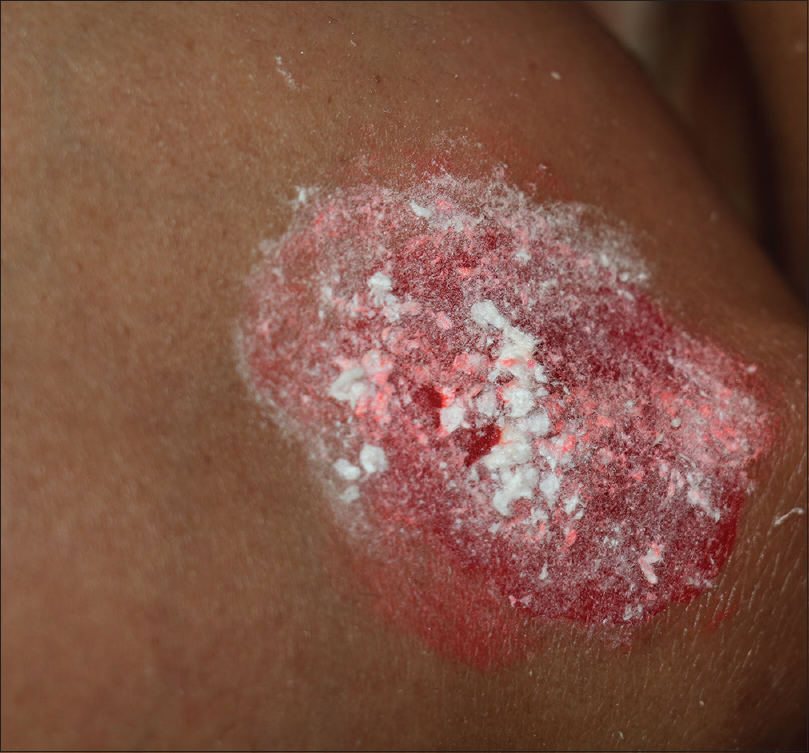 |
| Figure 1: Moulage of psoriasis |
We tried creating moulages for a range of skin diseases including psoriasis, eczema, erythema/purpura/erythema multiforme, nevi, vitiligo, pityriasis versicolor, tinea corporis, scabies, and blistering diseases [Figure - 1], [Figure - 2], [Figure - 3], [Figure - 4], [Figure - 5], [Figure - 6], [Figure - 7], [Figure - 8]. The cases were piloted in the year prior to the study, after approval and ethical clearance from the college curriculum committee and further refinements were then made accordingly. Volunteers were also financially compensated appropriately.
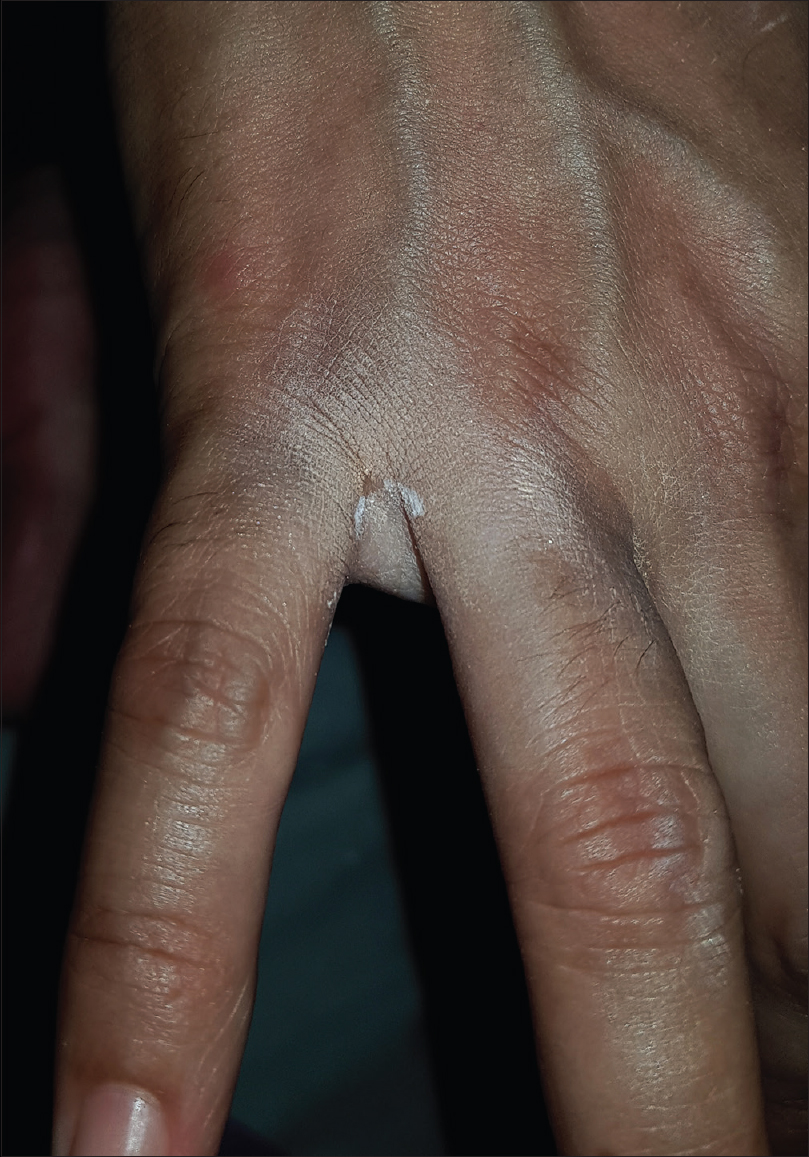 |
| Figure 2: Moulage of scabies |
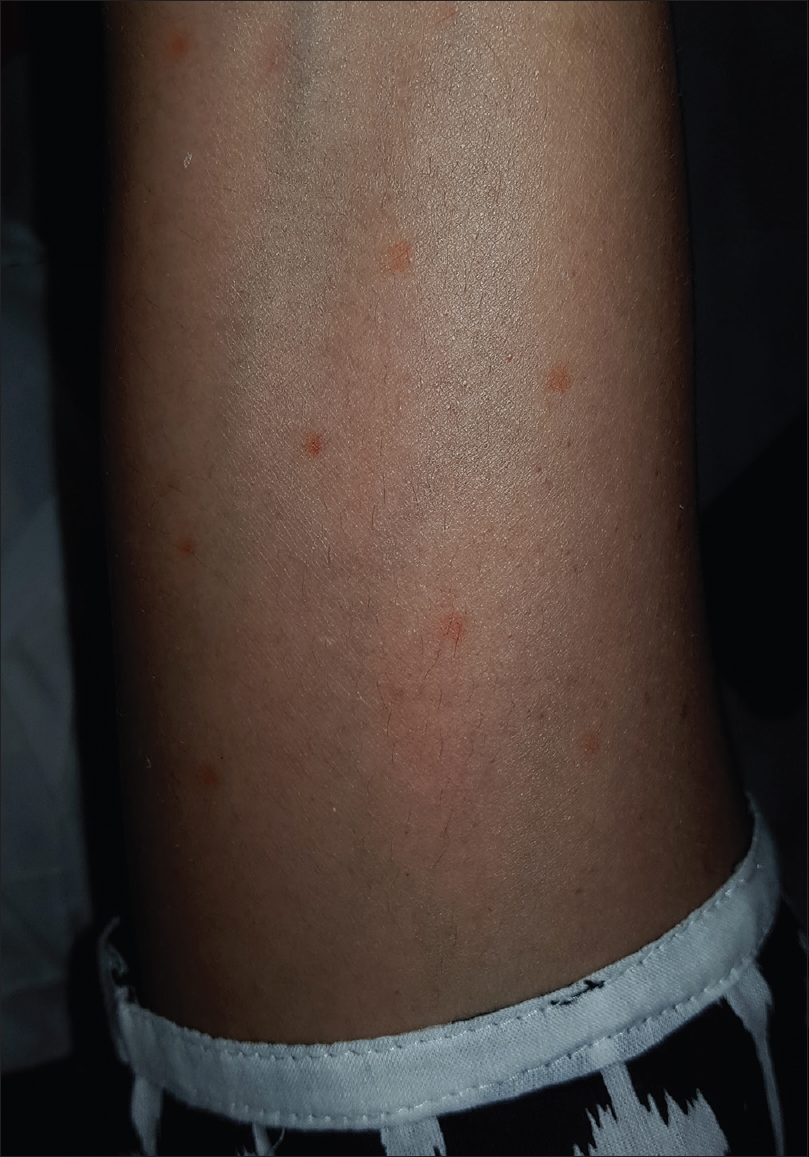 |
| Figure 3: Moulage of erythematous lesions for diascopy |
 |
| Figure 4: Moulage of erythema multiforme |
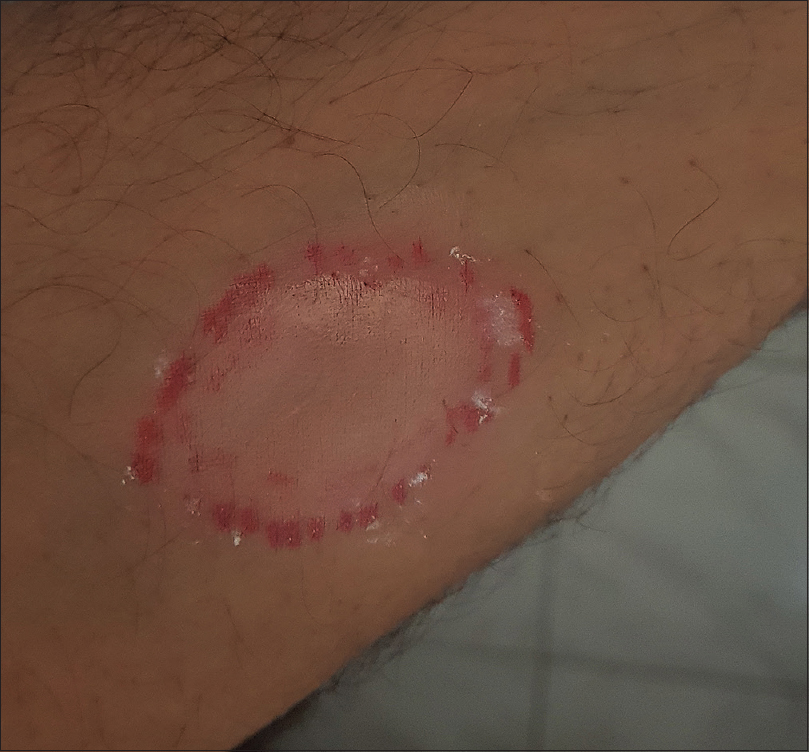 |
| Figure 5: Moulage of tinea corporis |
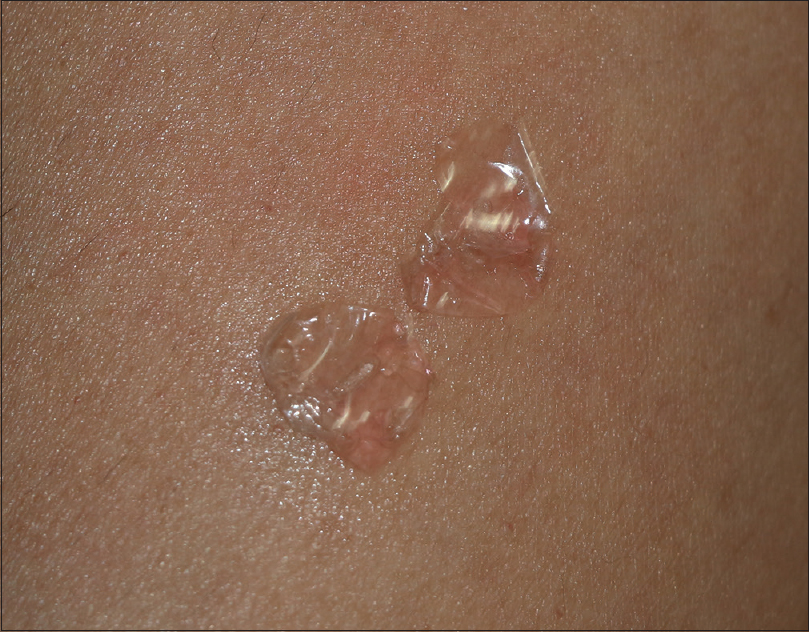 |
| Figure 6: Moulage of blistering dermatosis |
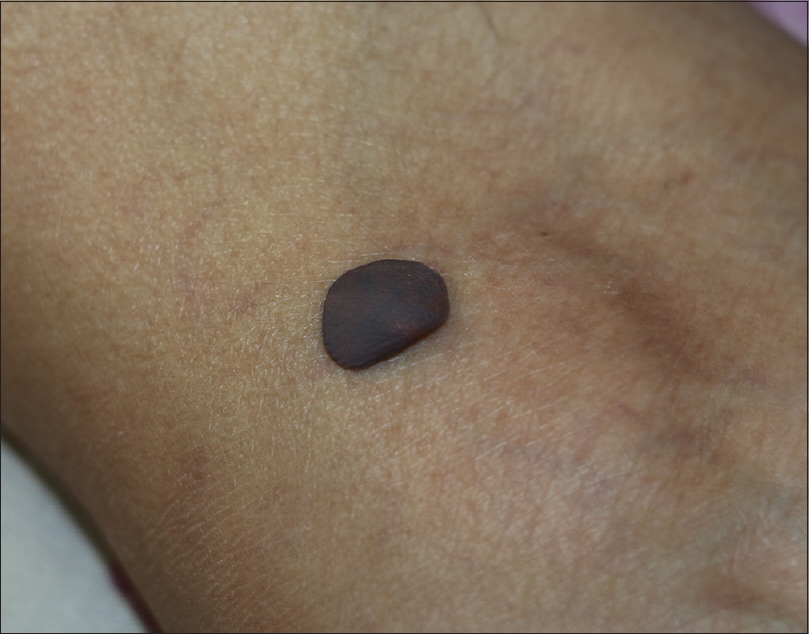 |
| Figure 7: Moulage of nevi/seborrheic keratosis |
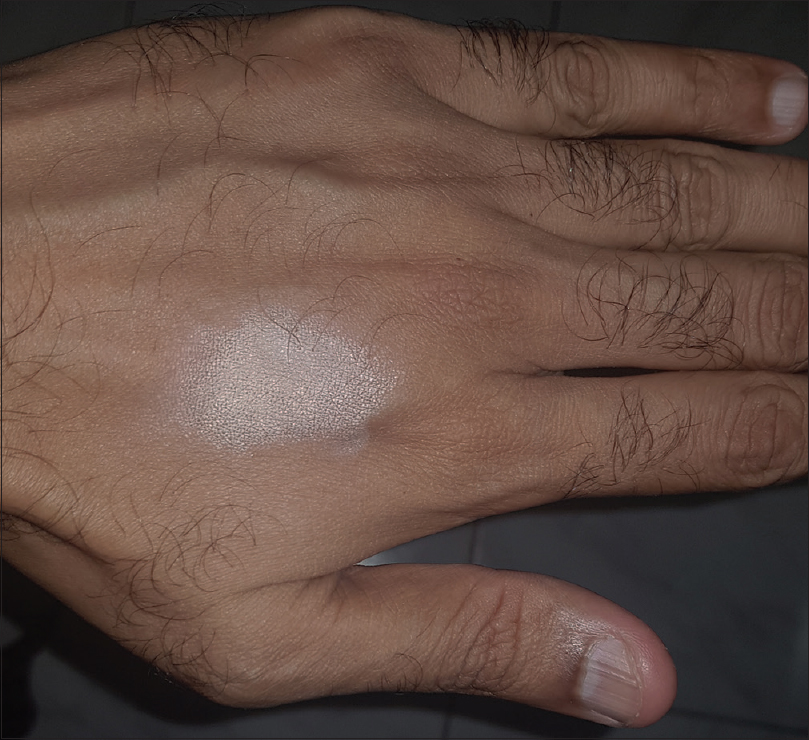 |
| Figure 8: Moulage of vitiligo |
For each quarter, the cases were chosen at least a week before and moulages were created on the day of the exam by the faculty after obtaining consent from the volunteers. For each quarter, all students had the same set of cases. The students were oriented in advance that simulated lesions would be included. Checklists for each station were finalized after peer and external review. The stations for which the moulages were used were examination skill stations.
Qualitative post-course feedback from the students and the faculty were collected. The course feedback is a standard 27 item questionnaire, collected a the end of each course, which includes questions related to assessment. Of these 24 questions are in the form of a 5 point Likert scale, while 3 are open ended questions. The feedback is part of the course evaluation and is collected at the end of each course, after the assessment. Discrimination (a measure of a test item's ability to discriminate between those who scored high on the total test and those who scored low) and difficulty (a measure of difficulty of a test item) indices of the stations using the moulages were compared with the other stations.
Results
The students and the faculty felt that the moulages used were realistic enough for using in an objective structured clinical examination. There was also consensus among the faculty that the application was practical. More importantly, the faculty agreed that the models were sufficiently realistic to use as an assessment tool for the description of skin lesions.
The most preferred models from the faculty side were psoriasis, eczema, scabies, tinea corporis, erythema multiforme and purpura. The faculty felt that these were easy to apply (less effort and time required) and, more importantly, these were amenable to special tests like the Auspitz sign in psoriasis. While other conditions like blistering diseases could also be created easily, they were not quite resistant to handling and needed frequent touching up again. Moreover, it was pointed out that it would be difficult to effectively perform special tests like bulla spread or Nikolsky sign in these cases.
Detailed inputs from the faculty included comments on the ease of use of some of the models—especially, psoriasis, scabies and purpura—both in terms of time required for application and the level of expertise required. For these conditions, frequent touch-ups were also not required. A single application was enough to last for one whole session. The other advantage, was that the stations and corresponding checklists could be planned and shortlisted in advance (unlike traditional OSCEs with real patients, which are dependent on the required cases being available on the day of the exam).
The faculty also mentioned that the moulages would help to improve uniformity and standardization across groups, although it was felt that it would be ideal for the same person to make the moulages for the same condition across groups to maintain uniformity better. The other obvious disadvantage pointed out by the faculty was that some conditions which are an integral part of the blueprint are not easily amenable to this form of moulage (especially hair and nail disorders).
Overall average reliability (Cronbach's alpha) of the moulage stations was more than 0.5, the lower, but acceptable value because we considered only two stations per quarter (the exact Cronbach's alpha for the stations in which the moulage was used was 0.55). There was no significant change in the overall internal consistency of the OSCE if the scores for the station's moulage were removed.
As far as other psychometrics were concerned, average difficulty and discrimination of the stations using the moulages were in an acceptable range (average difficulty index—0.78 and average discrimination index—0.68) and compared favorably with the other stations (average difficulty index—0.77 and average discrimination index—0.57).
Discussion
Assessment drives learning and it is important for the assessment tool to be both reliable and valid. OSCEs have been used in undergraduate dermatology assessment and have been shown to be an effective assessment tool.[3],[4],[5] One of the primary objectives of undergraduate dermatology courses is to train students in the identification and description of skin lesions. Traditionally, the corresponding learning outcomes were assessed using actual patients, in the form of a clinical case discussion or as spotters. Another option is the use of image-based electronic OSCE stations which have also been validated.[2],[6] The main limitation of image-based electronic OSCE stations is that it is difficult to assess certain hands-on skills and attitudes. Traditional OSCEs, on the other hand, are limited by their logistic needs. To be really reliable, a sufficient number of stations are needed, and ideally, the same stations should be used for a group of examinees. Also, checklists need to be prepared in advance. Checklists are case-dependent and corresponding cases are required on the day of the examination. With moulages, the cases can be finalized in advance, thus enabling the supervisor to focus on the checklists for those stations alone. Based on our study, we feel that using simulated patients with moulage overcomes all these difficulties. Standardized and simulated patients are often used in OSCEs in general and while it may work well enough for a case involving history-taking in dermatology, for clinical examination, a standardized/simulated skin lesion needs to be present and this is where moulage techniques are really helpful. A short study among 3rd-year medical students, involving two stations (one case of herpes zoster and one case of herpes simplex) in a single OSCE suggested that moulages could be useful.[7] Another study based on a single OSCE for physical assistants concluded that the use of moulages increased the realism of the standardized patient encounter.[8] Gormley et al. described the use of “transfer tattoos,” using specialized software, simulating a case of melanoma which was used in an OSCE for 4th-year medical students. In this study, too, based on the student feedback, it was concluded that the “transfer tattoo” combined with simulated patients improved the realism and psychometrics of the exams. Like in our study the psychometrics were similar or better as compared to other standard stations. Also, effective scripts and training of the simulated patients are essential for the station to be really effective and this too requires a pool of motivated and well trained simulated patients.[9]
The application process is very easy and is intuitive. No special training is required. The materials used are safe, cheap and easily available. Professional moulage kits tend to be costly and require specialized training prior to use.
Simple moulages can also be used as effective tools for teaching/demonstration of skin lesions and special tests.
Limitation
The main limitation of our study was that all the conditions relevant to the curriculum blueprint were not amenable to our method (especially conditions like nail diseases, alopecias and other hair disorders). We did not do a detailed item analysis based on the checklist and the average reliability coefficient of approximately 0.5 is not ideal. The difficulty indices indicate an easy exam in general, and hence, generalizing the results would be difficult. Feedback was not taken from the volunteers, which was another major limitation of our study. We feel that more detailed studies of OSCEs incorporating a larger number of stations with moulages are warranted to establish the validity and reliability of this modality as an assessment tool in dermatology.
Conclusion
Moulage-based simulations can be a simple and effective tool for creating effective objective structured clinical examinations in dermatology. We would also recommend training dermatology faculty in effective moulage techniques for assessment purposes.
Financial support and sponsorship
Nil.
Conflicts of interest
There are no conflicts of interest.
| 1. |
Worm AM, Sinisalo H, Eilertsen G, Šhrén E, Meyer I. Dermatological moulage collections in the Nordic countries. J Eur Acad Dermatol Venereol 2018;32:570-80.
[Google Scholar]
|
| 2. |
Kaliyadan F, Khan AS, Kuruvilla J, Feroze K. Validation of a computer based objective structured clinical examination in the assessment of undergraduate dermatology courses. Indian J Dermatol Venereol Leprol 2014;80:134-6.
[Google Scholar]
|
| 3. |
Chaudhary R, Grover C, Bhattacharya SN, Sharma A. Computer assisted objective structured clinical examination versus objective structured clinical examination in assessment of dermatology undergraduate students. Indian J Dermatol Venereol Leprol 2017;83:448-52.
[Google Scholar]
|
| 4. |
Grover C, Bhattacharya SN, Pandhi D, Singal A, Kumar P. Computer assisted objective structured clinical examination: A useful tool for dermatology undergraduate assessment. Indian J Dermatol Venereol Leprol 2012;78:519.
[Google Scholar]
|
| 5. |
Saceda-Corralo D, Fonda-Pascual P, Moreno-Arrones ÓM, Alegre-Sánchez A, Hermosa-Gelbard Á, Jiménez-Gómez N, et al. Objective structured clinical examination as an assessment tool for clinical skills in dermatology. Actas Dermosifiliogr 2017;108:237-43.
[Google Scholar]
|
| 6. |
Kumar GR, Madhavi S, Karthikeyan K, Thirunavakarasu MR. Role of clinical images based teaching as a supplement to conventional clinical teaching in dermatology. Indian J Dermatol 2015;60:556-61.
[Google Scholar]
|
| 7. |
Sabzwari SR, Afzal A, Nanji K. Mimicking rashes: Use of moulage technique in undergraduate assessment at the aga khan university, Karachi. Educ Health (Abingdon) 2017;30:60-3.
[Google Scholar]
|
| 8. |
Zorn J, Snyder J, Guthrie J. Use of moulage to evaluate student assessment of skin in an objective structured clinical examination. J Physician Assist Educ 2018;29:99-103.
[Google Scholar]
|
| 9. |
Gormley G, Menary A, Layard B, Hart N, McCourt C. Temporary tattoos: A novel objective structured clinical examination assessment tool. Clin Teach 2013;10:251-7.
[Google Scholar]
|
Fulltext Views
4,192
PDF downloads
2,257





